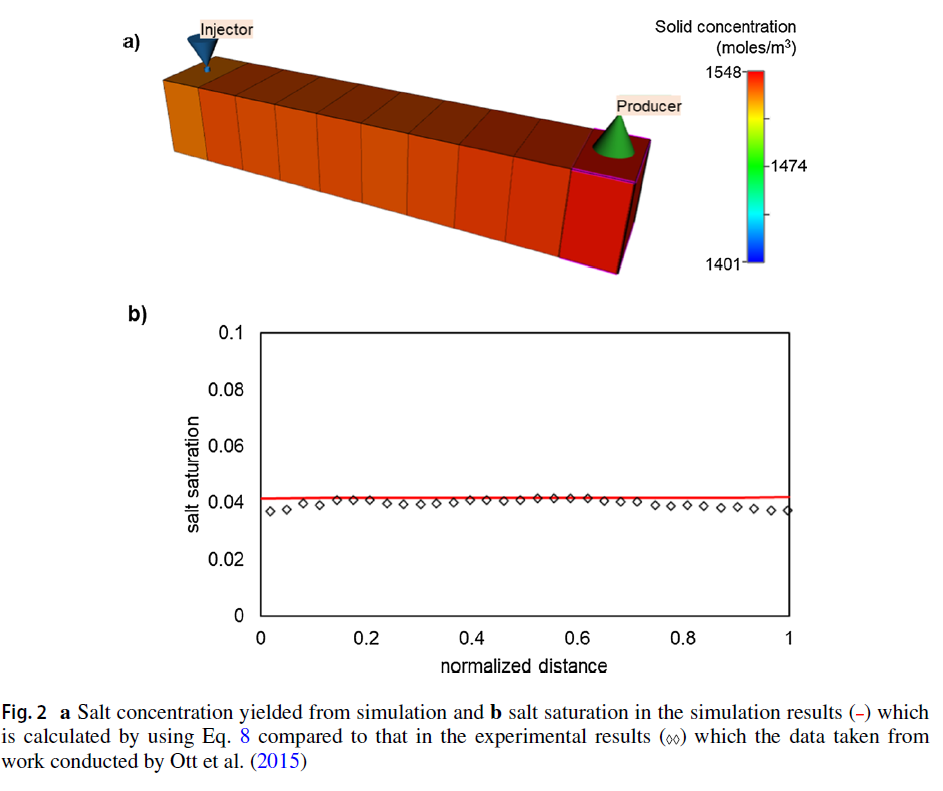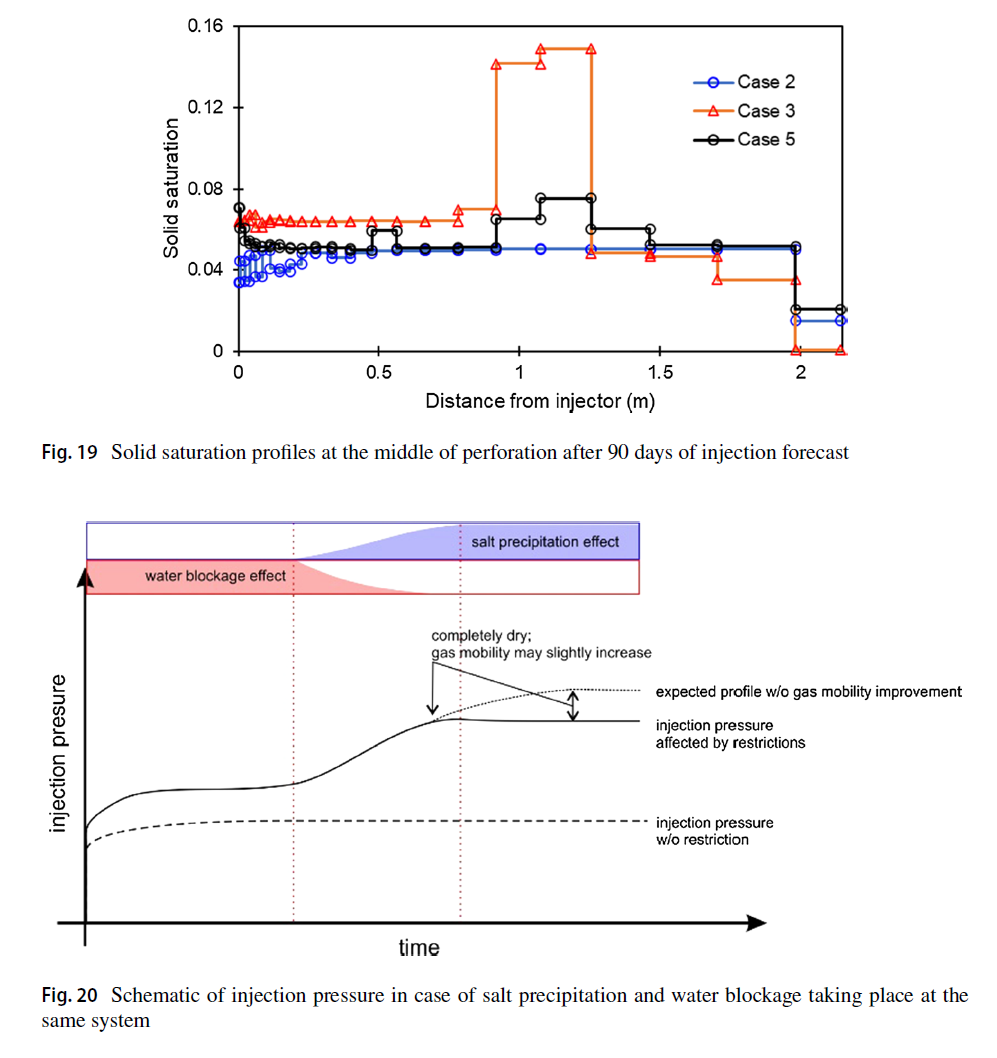Simulation Study of sc-CO2 Based Silylation for Decreasing Severity of Water Blockage and Salt Precipitation during Geological CO2 Storage in Deep Saline Aquifers
本文研究了深部咸水层二氧化碳地下封存方面的问题。尽管深部咸水层具有较大容量和较低的资源冲突可能性,但在CO2注入过程中可能会出现一些问题。由于通常这些含水层具有较高的矿化度,所以盐析可能会成为一个问题,尤其是在水锁发生时,这种问题可能会加剧。然而,通过改变岩石润湿性为亲水性,可以减轻水锁,并降低盐析的可能性。之前的实验表明,硅烷化处理的超临界二氧化碳可以有效地降低岩石润湿性。
本研究通过建立数值模型,综合考虑了多相流体流动、水蒸发和盐析效应,评估了硅烷化处理对CO2注入引起的盐析的有效性。模拟结果显示,盐析导致的渗透性下降更加显著,尤其高矿化度储层的注入能力下降更为突出。通过硅烷化处理,可以减少盐析和水锁对相对渗透率的综合影响,最多可以减少7%。从技术经济的角度考虑,建议在CO2注入计划中尽早实施这种方法,以减少盐析。
Abstract
Deep saline aquifers are often favorable for underground CO2 sequestration due to their large capacity and relatively low likelihood for resource conflicts. However, many possible issues can arise during CO2 injection. Often these aquifers have a significant salinity level (as these often present minimal resource conflict issues) and as such salt precipitation near the injection wellbore can be problematic. Furthermore, when water blockage occurs, salt precipitation can be exacerbated since large amounts of water remain near the wellbore. Altering the rock wettability towards less water-wet can alleviate water blockage and in turn reduce the likelihood or severity of salt precipitation. Previous lab experiments have shown that supercritical CO2 (sc-CO2)-based silylation can effectively functionalize rock surfaces with hydrophobic silanes. In this study, numerical models were constructed to evaluate the combined effects of multi-phase fluid flow, water evaporation and salt precipitation assuming a change in wettability (thus impacting the relative permeability characteristics of the reservoir) resulting from the silylation process. The aim of this study is to evaluate the efficacy of this chemical treatment to address near wellbore salt precipitation induced by CO2 injection. According to the simulation results, a decrease in injectivity due to salt precipitation is more significant when water blockage is also present. Injectivity is deteriorated prominently in high salinity reservoirs with water blockage since evaporation into the injected CO2 phase will cause significant salt precipitation. In a representative formation, the injectivity decline is worse (up to 68.6% relative injectivity change (RIC)) when both salt precipitation and water blockage are considered since the latter provides more trapped brine inducing more salt accumulation around the wellbore. With hydrophobic silylation, the combined effects of salt precipitation and water blockage on RIC are decreased on an absolute basis by up to 7%. Depending on techno-economic considerations, this method is encouraged to be implemented as early as possible during a CO2 injection program to minimize salt accumulation from the outset.




结论
根据模拟结果显示,盐析导致的渗透性下降比水堵塞更为显著。盐析通过在孔隙中形成额外的固体物质来减少孔隙空间,而水锁则通过影响CO2的流动性,由于相对较高的不可减小水饱和度而产生影响。水堵塞的负面影响会随着水的蒸发而逐渐减弱,而盐析则会开始在孔隙空间内增长。当盐析和水堵塞同时发生时,高度截留的盐水会更严重地恶化注入性能(相对注入性能变化为68.6%)。
不同的毛细现象可能会导致局部的盐析,这可能是由于水锁引起的非均质性,或者是由于地质结构中天然存在的深层盐水含水层。除了基于超临界CO2的硅化改变润湿性的能力外,应用这种方法还间接减轻了盐析的严重程度。通过改变润湿性,一些被截留的盐水得以移动,从而降低了不可减小水饱和度。这种现象可以防止大量的盐分在注入井穿孔附近积累。在由水锁引起的盐析情况下,这种方法可以抵消相对注入性能变化的5%至7%(基于绝对值)。此外,由于这种方法在盖住孔壁的盐析发生时无效,因此建议在进行连续CO2注入进行地质封存之前实施这种方法。
Conclusions
According to the simulation result, a decrease in injectivity due to salt precipitation is more significant than that due to water blockage. Salt precipitation decreases pore space by forming additional solid in it, while water blockage affects the mobility of CO2 due to relatively high irreducible water saturation. The negative impact of water blockage gradually diminishes (as the water evaporates) while salt starts growing within the pore space. With a high level of trapped brine, the injectivity is deteriorated more severely (up to 68.6% of relative injectivity change (RIC)) when both salt precipitation and water blockage occur. Different capillary behavior may induce localized precipitation considering the heterogeneity either caused by water blockage or naturally employed in the geological structure of a deep saline aquifer.
Beside the ability of sc-CO2 based silylation in altering wettability, applying this method reduces the severity of salt precipitation indirectly. The alteration turns some trapped brine moveable and thus decreases irreducible water saturation. This phenomenon prevents large accumulation of salt near perforation of the injection well. In case of salt precipitation endorsed by water blockage, this method counteracted the injectivity around 5 to 7% of RIC (absolute basis). In addition, this method is encouraged to be implemented before continuous CO2 injection for the geological sequestration because the expected mechanism will not work when salt precipitation comes up covering the pore surface.
